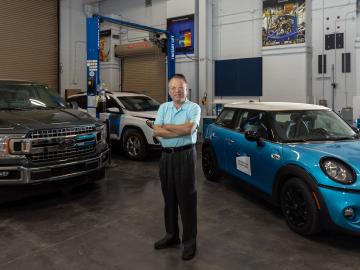
Filter News
Area of Research
- (-) Energy Science (38)
- (-) Materials (20)
- (-) Neutron Science (10)
- Biology and Environment (12)
- Computational Biology (1)
- Computer Science (2)
- Fusion and Fission (6)
- Isotopes (17)
- Materials for Computing (6)
- National Security (14)
- Nuclear Science and Technology (7)
- Quantum information Science (1)
- Supercomputing (49)
News Type
News Topics
- (-) Advanced Reactors (3)
- (-) Composites (3)
- (-) Computer Science (17)
- (-) Cybersecurity (6)
- (-) Isotopes (6)
- (-) Space Exploration (3)
- (-) Transportation (23)
- 3-D Printing/Advanced Manufacturing (29)
- Artificial Intelligence (7)
- Big Data (3)
- Bioenergy (14)
- Biology (7)
- Biomedical (11)
- Biotechnology (1)
- Buildings (14)
- Chemical Sciences (10)
- Clean Water (6)
- Coronavirus (11)
- Critical Materials (1)
- Energy Storage (27)
- Environment (27)
- Exascale Computing (1)
- Fossil Energy (2)
- Fusion (3)
- Grid (14)
- High-Performance Computing (4)
- Hydropower (1)
- Machine Learning (4)
- Materials (27)
- Materials Science (30)
- Mathematics (2)
- Mercury (1)
- Microelectronics (1)
- Microscopy (10)
- Nanotechnology (12)
- National Security (2)
- Neutron Science (60)
- Nuclear Energy (12)
- Partnerships (5)
- Physics (12)
- Polymers (6)
- Quantum Computing (2)
- Quantum Science (2)
- Security (4)
- Simulation (1)
- Summit (4)
Media Contacts

Scientists at the Department of Energy Manufacturing Demonstration Facility at ORNL have their eyes on the prize: the Transformational Challenge Reactor, or TCR, a microreactor built using 3D printing and other new approaches that will be up and running by 2023.

Researchers at the Department of Energy’s Oak Ridge National Laboratory (ORNL) in late February demonstrated a 20-kilowatt bi-directional wireless charging system installed on a UPS medium-duty, plug-in hybrid electric delivery truck.

In the race to identify solutions to the COVID-19 pandemic, researchers at the Department of Energy’s Oak Ridge National Laboratory are joining the fight by applying expertise in computational science, advanced manufacturing, data science and neutron science.

Each year, approximately 6 billion gallons of fuel are wasted as vehicles wait at stop lights or sit in dense traffic with engines idling, according to US Department of Energy estimates.

Scientists at have experimentally demonstrated a novel cryogenic, or low temperature, memory cell circuit design based on coupled arrays of Josephson junctions, a technology that may be faster and more energy efficient than existing memory devices.

Researchers at ORNL have developed a quantum chemistry simulation benchmark to evaluate the performance of quantum devices and guide the development of applications for future quantum computers.

ORNL computer scientist Catherine Schuman returned to her alma mater, Harriman High School, to lead Hour of Code activities and talk to students about her job as a researcher.

Students often participate in internships and receive formal training in their chosen career fields during college, but some pursue professional development opportunities even earlier.

A modern, healthy transportation system is vital to the nation’s economic security and the American standard of living. The U.S. Department of Energy’s Oak Ridge National Laboratory (ORNL) is engaged in a broad portfolio of scientific research for improved mobility

In Hong Wang’s world, nothing is beyond control. Before joining Oak Ridge National Laboratory as a senior distinguished researcher in transportation systems, he spent more than three decades studying the control of complex industrial systems in the United Kingdom.


